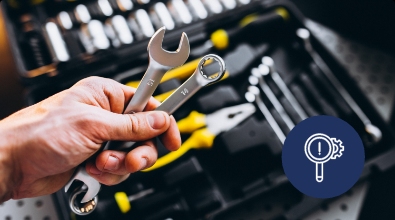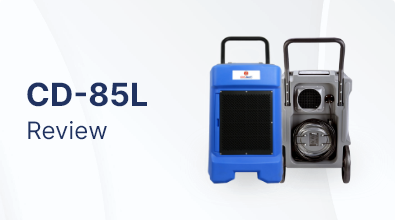Introduction.
Let's learn today the process of selecting the best industrial dehumidifier. An industrial dehumidification system is a vital device for maintaining the proper moisture level in commercial facilities. A suitable humidity level will protect machines from corrosion, preserve produced goods, and create a comfortable climate to increase the efficiency of the workers. So let's get started!
Step 1: Site survey for assessing metrics.
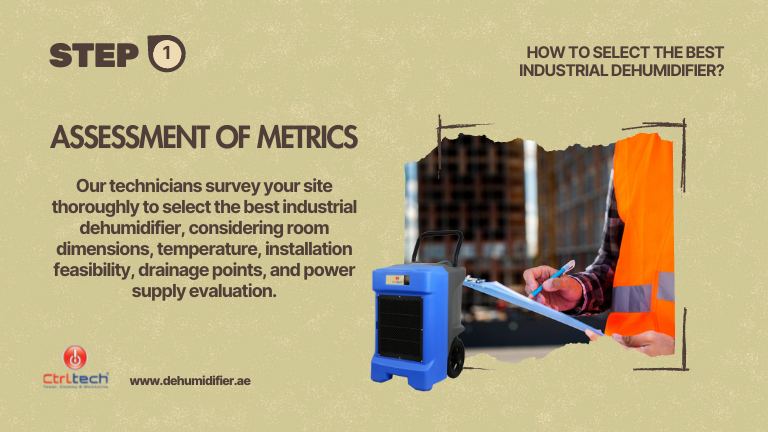
Conducting a thorough site survey is the first crucial step in selecting the best industrial dehumidifier for your needs. Our team of skilled technicians and engineers will personally visit your site to gather all the essential information required for the process. ..
They will carefully assess the dimensions of the room, taking accurate measurements to ensure precise calculations. Additionally, we will evaluate the existing room temperature, as this plays a vital role in determining the appropriate dehumidifier capacity.
During the site survey, our experts will also pay close attention to various factors that can impact the installation and performance of the dehumidifier. This includes assessing the feasibility of installing the unit, considering aspects such as available space, accessibility, and any potential obstacles.
Proper planning of the installation process ensures that the dehumidifier fits seamlessly into your industrial space.
Another aspect our technicians will focus on is identifying suitable drainage points for the condensate removal. We will carefully examine the layout of the room to determine the most convenient and effective locations for drainage connections. This is essential for ensuring the proper functioning and maintenance of the dehumidifier.
Additionally, the power supply availability will be evaluated to ensure that the selected dehumidifier can be easily connected and operated without any electrical complications. Our technicians will assess the proximity of power outlets and verify if the electrical infrastructure can support the power requirements of the dehumidifier.
By conducting a comprehensive site survey, our dedicated team will gather all the necessary information about your industrial space, enabling us to make accurate assessments and recommendations for the most suitable dehumidifier.
This personalized approach ensures that the selected dehumidifier meets your specific requirements and performs optimally in maintaining the desired humidity levels within your industrial environment. Read more
Step 2: Understanding client requirements.
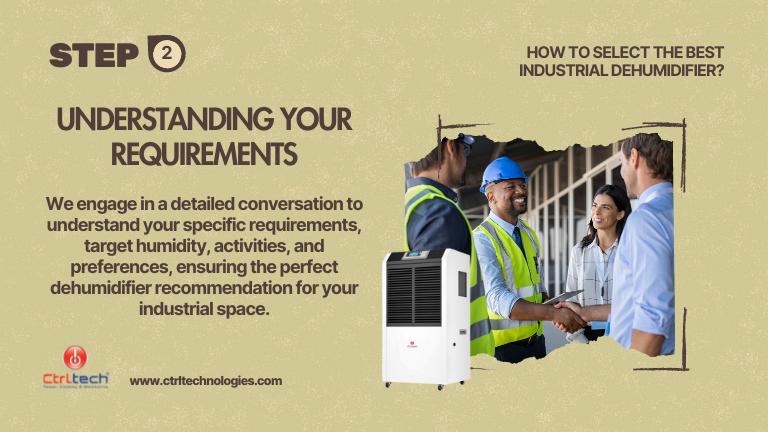
The next step in the process includes our indulgence in a detailed conversation with you regarding any specific parameters or preferences that you might have concerning your requirements on the dehumidifier...
This allows us to gain a deep understanding of your specific requirements for industrial dehumidification. We want to ensure that we address your unique needs and provide you with the most effective solution.
During this discussion, we will actively listen to your concerns and objectives. Our goal is to determine the average humidity level that you desire for your industrial space.
By understanding this target humidity, we can select a dehumidifier that will effectively regulate the moisture levels to meet your expectations.
Additionally, we will inquire about the type of activities that typically take place in the room for which dehumidification is required. This information is vital as different industrial processes generate varying levels of moisture. By gaining insight into your specific activities, we can select a dehumidifier that is capable of handling the moisture load effectively.
Whether it's specific features you need in a dehumidifier or any limitations we should be aware of, your input is invaluable in guiding our selection process.
Through open and thorough communication, we aim to build a strong partnership with you, ensuring that the dehumidifier we recommend aligns perfectly with your expectations. Read more
Step 3: Selecting the right dehumidifier type.
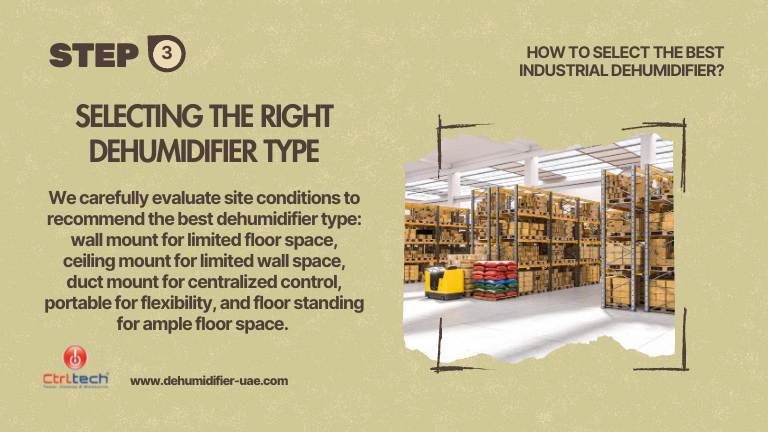
Selecting the appropriate type of dehumidifier unit is a crucial decision in ensuring efficient moisture control in your industrial space. We understand that every industrial environment is unique, and different types of dehumidifiers offer distinct advantages based on site conditions and requirements...
Our experienced team will carefully evaluate the site conditions discussed during the site survey to determine the best fit for your needs. There are several types of dehumidifiers to consider:
Wall mount dehumidifiers: These units are mounted on the wall using additional hardware brackets, saving valuable floor space. They are ideal for smaller industrial spaces where floor space is limited but vertical space is available.
Ceiling mount dehumidifiers: Designed to be suspended from the ceiling, these units are an excellent choice for spaces with limited wall space or when floor-mounted options are not feasible. Ceiling mount dehumidifiers provide effective moisture control without interfering with the layout or operations of the industrial area.
Duct mount dehumidifiers: These units are integrated into the existing ductwork system, allowing for centralized dehumidification. Duct mount dehumidifiers are suitable for larger industrial spaces or when you require dehumidification in multiple areas simultaneously.
Portable dehumidifiers: Offering flexibility and mobility, portable units are easily maneuverable and can be used in various locations as needed. They are an ideal choice for temporary dehumidification needs or when you require mobility and versatility.
Floor standing dehumidifiers: These units are freestanding and can be placed on the floor, providing a stable and reliable solution. Floor standing dehumidifiers are suitable for medium to large industrial spaces where floor space is ample.
Based on the information gathered during the site survey and the specific requirements discussed with you, we will recommend the most suitable type of dehumidifier for your industrial space. Read more
Step 4: Unit capacity calculation.
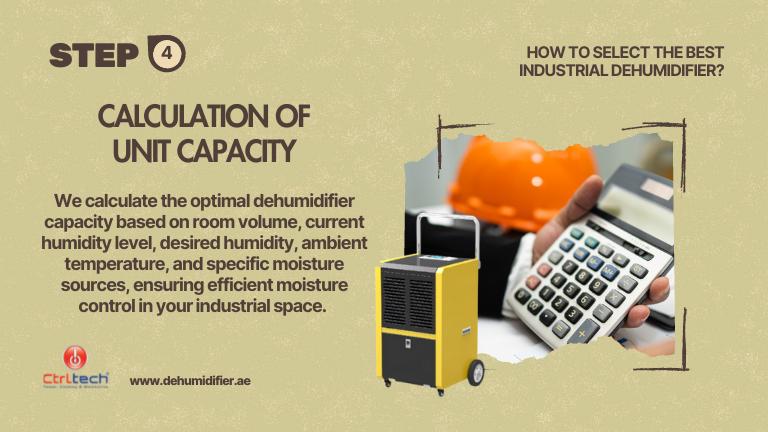
Calculating the required capacity of the dehumidifier unit is a critical step in ensuring effective moisture management in your industrial space. This calculation takes into consideration various factors to determine the optimal capacity of the dehumidifier that will meet your specific needs...
To begin, our team will consider the volume of the room. By accurately measuring the dimensions gathered during the site survey, we calculate the total cubic footage or cubic meters of the space. This volume is a key factor in determining the capacity required to adequately dehumidify the area.
Next, we assess the current humidity level in the industrial space. Our technicians may use specialized equipment to measure and analyze the existing humidity conditions. This information helps us understand the extent of dehumidification needed to achieve your desired humidity level.
Taking into account the desired humidity level, we calculate the moisture removal capacity required. It is essential to select a dehumidifier with the appropriate capacity to ensure efficient moisture control and prevent overworking the unit.
Other factors that influence capacity calculation include the ambient temperature of the space and any specific moisture-generating processes or equipment present. These factors help us determine the dehumidifier's ability to perform optimally under the prevailing conditions.
By conducting a comprehensive capacity calculation, we can recommend a dehumidifier that is appropriately sized for your industrial space. An accurately sized dehumidifier ensures efficient moisture removal, prevents issues like condensation, mold growth, and corrosion, and promotes a healthier and more comfortable working environment. Read more
Step 5: Vendor selection and installation.

Researching and selecting a reputable vendor or authorized dealer is essential to ensure that you receive a high-quality industrial dehumidifier and excellent customer service. ..
Our team recommends conducting thorough research on potential vendors or authorized dealers in the market. Start by checking their reputation and customer reviews.
Look for feedback and testimonials from previous clients who have purchased dehumidifiers from them. This will give you valuable insights into the vendor's reliability, product quality, and after-sales service.
Consider vendors who have a proven track record in supplying industrial dehumidifiers. Look for those with extensive experience and a strong presence in the industry. Established vendors often have a wide range of dehumidifier options, ensuring you have access to the latest technologies and models.
Ensure that the vendor you choose is an authorized dealer of the dehumidifier brand you are interested in. Authorized dealers have direct access to genuine products, manufacturer support, and warranties. This ensures that you receive authentic and reliable equipment.
Additionally, evaluate the vendor's customer service and technical support. Opt for a vendor who is responsive, knowledgeable, and readily available to address any inquiries or concerns you may have.
A reputable vendor will prioritize customer satisfaction and provide timely assistance throughout your dehumidification journey.
It is also beneficial to inquire about maintenance and service agreements offered by the vendor. Understanding their post-purchase support, including servicing, repairs, and spare parts availability, is crucial for the long-term performance and durability of your dehumidifier.
By selecting a reputable vendor or authorized dealer, you can have peace of mind knowing that you are investing in a high-quality dehumidifier and receiving reliable support.
Their expertise and commitment to customer satisfaction will ensure a smooth purchasing process and provide you with the necessary assistance during installation and beyond.
Read more








